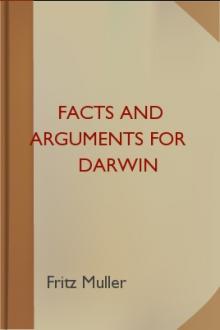Facts and Arguments for Darwin by Fritz Muller (read along books .TXT) 📕

- Author: Fritz Muller
- Performer: -
Book online «Facts and Arguments for Darwin by Fritz Muller (read along books .TXT) 📕». Author Fritz Muller
Descendants therefore reach a new goal, either by deviating sooner or later whilst still on the way towards the form of their parents, or by passing along this course without deviation, but then, instead of standing still, advance still farther.
The former mode will have had a predominant action where the posterity of common ancestors constitutes a group of forms standing upon the same level in essential features, as the whole of the Amphipoda, Crabs, or Birds. On the other hand we are led to the assumption of the second mode of progress, when we seek to deduce from a common original form, animals some of which agree with young states of others.
In the former case the developmental history of the descendants can only agree with that of their ancestors up to a certain point at which their courses separate,—as to their structure in the adult state it will teach us nothing. In the second case the entire development of the progenitors is also passed through by the descendants, and, therefore, so far as the production of a species depends upon this second mode of progress, the historical development of the species will be mirrored in its developmental history. In the short period of a few weeks or months, the changing forms of the embryo and larvae will pass before us, a more or less complete and more or less true picture of the transformations through which the species, in the course of untold thousands of years, has struggled up to its present state.
(FIGURES 65 TO 67. Young Tubicolar worms, magnified with the simple lens about 6 diam.:
FIGURE 65.* Without operculum, Protula-stage. (* Figure 65 is drawn from memory, as the little animals, which I at first took for young Protulae, only attracted my attention when I remarked the appearance of the operculum, which induced me to draw them.)
FIGURE 66. With a barbate opercular peduncle, Filograna-stage;
FIGURE 67. With a naked opercular peduncle, Serpula-stage.)
One of the simplest examples is furnished by the development of the Tubicolar Annelids; but from its very simplicity it appears well adapted to open the eyes of many who, perhaps, would rather not see, and it may therefore find a place here. Three years ago I found on the walls of one of my glasses some small worm-tubes (Figure 65), the inhabitants of which bore three pairs of barbate branchial filaments, and had no operculum. According to this we should have been obliged to refer them to the genus Protula. A few days afterwards one of the branchial filaments had become thickened at the extremity into a clavate operculum (Figure 66), when the animals reminded me, by the barbate opercular peduncle, of the genus Filograna, only that the latter possesses two opercula. In three days more, during which a new pair of branchial filaments had sprouted forth, the opercular peduncle had lost its lateral filaments (Figure 67), and the worms had become Serpulae. Here the supposition at once presents itself that the primitive tubicolar worm was a Protula,—that some of its descendants, which had already become developed into perfect Protulae, subsequently improved themselves by the formation of an operculum which might protect their tubes from inimical intruders,—and that subsequent descendants of these latter finally lost the lateral filaments of the opercular peduncle, which they, like their ancestors, had developed.
What say the schools to this case? Whence and for what purpose, if the Serpulae were produced or created as ready-formed species, these lateral filaments of the opercular peduncle? To allow them to sprout forth merely for the sake of an invariable plan of structure, even when they must be immediately retracted again as superfluous, would certainly be an evidence rather of childish trifling or dictatorial pedantry, than of infinite wisdom. But no, I am mistaken; from the beginning of all things the Creator knew, that one day the inquisitive children of men would grope about after analogies and homologies, and that Christian naturalists would busy themselves with thinking out his Creative ideas; at any rate, in order to facilitate the discernment by the former that the opercular peduncle of the Serpulae is homologous with a branchial filament, He allowed it to make a detour in its development, and pass through the form of a barbate branchial filament.
The historical record preserved in developmental history is gradually EFFACED as the development strikes into a constantly straighter course from the egg to the perfect animal, and it is frequently SOPHISTICATED by the struggle for existence which the free-living larvae have to undergo.
Thus as the law of inheritance is by no means strict, as it gives room for individual variations with regard to the form of the parents, this is also the case with the succession in time of the developmental processes. Every father of a family who has taken notice of such matters, is well aware that even in children of the same parents, the teeth, for example, are not cut or changed, either at the same age, or in the same order. Now in general it will be useful to an animal to obtain as early as possible those advantages by which it sustains itself in the struggle for existence. A precocious appearance of peculiarities originally acquired at a later period will generally be advantageous, and their retarded appearance disadvantageous; the former, when it appears accidentally, will be preserved by natural selection. It is the same with every change which gives to the larval stages, rendered multifarious by crossed and oblique characters, a more straightforward direction, simplifies and abridges the process of development, and forces it back to an earlier period of life, and finally into the life of the egg.
As this conversion of a development passing through different young states into a more direct one, is not the consequence of a mysterious inherent impulse, but dependent upon advances accidentally presenting themselves, it may take place in the most nearly allied animals in the most various ways, and require very different periods of time for its completion. There is one thing, however, that must not be overlooked here. The historical development of a species can hardly ever have taken place in a continuously uniform flow; periods of rest will have alternated with periods of rapid progress. But forms, which in periods of rapid progress were severed from others after a short duration, must have impressed themselves less deeply upon the developmental history of their descendants, than those which repeated themselves unchanged, through a long series of successive generations in periods of rest. These more fixed forms, less inclined to variation, will present a more tenacious resistance in the transition to direct development, and will maintain themselves in a more uniform manner and to the last, however different may be the course of this process in other respects.
In general, as already stated, it will be advantageous to the young to commence the struggle for existence in the form of their parents and furnished with all their advantages—in general, but not without exceptions. It is perfectly clear that a brood capable of locomotion is almost indispensable to attached animals, and that the larvae of sluggish Mollusca, or of worms burrowing in the ground, etc., by swarming briskly through the sea perform essential services by dispersing the species over wider spaces. In other cases a metamorphosis is rendered indispensable by the circumstance that a division of labour has been set up between the various periods of life; for example, that the larvae have exclusively taken upon themselves the business of nourishment. A further circumstance to be taken into consideration is the size of the eggs,—a simpler structure may be produced with less material than a more compound one,—the more imperfect the larva, the smaller may the egg be, and the larger is the number of these that the mother can furnish with the same expenditure of material. As a rule, I believe indeed, this advantage of a more numerous brood will not by any means outweigh that of a more perfect brood, but it will do so in those cases in which the chief difficulty of the young animals consists in finding a suitable place for their development, and in which, therefore, it is of importance to disperse the greatest possible number of germs, as in many parasites.
As the conversion of the original development with metamorphosis into direct development is here under discussion, this may be the proper place to say a word as to the already indicated absence of metamorphosis in fresh-water and terrestrial animals the marine allies of which still undergo a transformation. This circumstance seems to be explicable in two ways. Either species without a metamorphosis migrated especially into the fresh waters, or the metamorphosis was more rapidly got rid of in the emigrants than in their fellows remaining in the sea.
Animals without a metamorphosis would naturally transfer themselves more easily to a new residence, as they had only themselves and not at the same time multifarious young forms to adapt to the new conditions. But in the case of animals with a metamorphosis, the mortality among the larvae, always considerable, must have become still greater under new than under accustomed conditions, every step towards the simplification of the process of development must therefore have given them a still greater preponderance over their fellows, and the effacing of the metamorphosis must have gone on more rapidly. What has taken place in each individual case, whether the species has immigrated after it had lost the metamorphosis, or lost the metamorphosis after its immigration, will not always be easy to decide. When there are marine allies without, or with only a slight metamorphosis, like the Lobster as the cousin of the Crayfish, we may take up the former supposition; when allies with a metamorphosis still live upon the land or in fresh water, as in the case of Gecarcinus, we may adopt the latter.
That besides this gradual extinction of the primitive history, a FALSIFICATION of the record preserved in the developmental history takes place by means of the struggle for existence which the free-living young states have to undergo, requires no further exposition. For it is perfectly evident that the struggle for existence and natural selection combined with this, must act in the same way, in change and development, upon larvae which have to provide for themselves, as upon adult animals. The changes of the larvae, independent of the progress of the adult animal, will become the more considerable, the longer the duration of the life of the larva in comparison to that of the adult animal, the greater the difference in their mode of life, and the more sharply marked the division of labour between the different stages of development. These processes have to a certain extent an action opposed to the gradual extinction of the primitive history; they increase the differences between the individual stages of development, and it will be easily seen how even a straightforward course of development may be again converted by them into a development with metamorphosis. By this means many, and it seems to me valid reasons may be brought up in favour of the opinion that the most ancient Insects approached more nearly to the existing Orthoptera, and perhaps to the wingless Blattidae, than to any other order, and that the “complete metamorphosis” of the Beetles, Lepidoptera, etc., is





Comments (0)